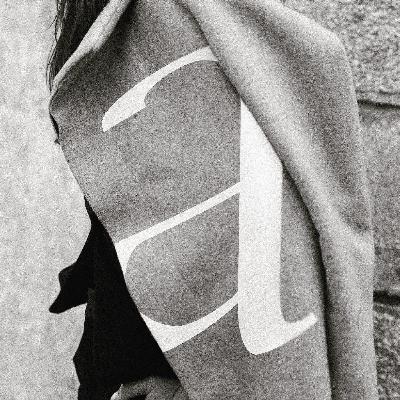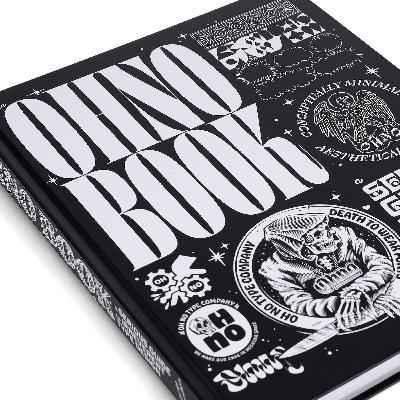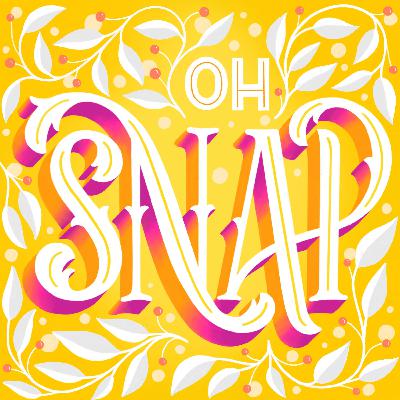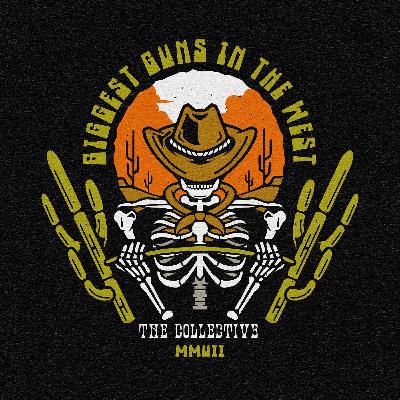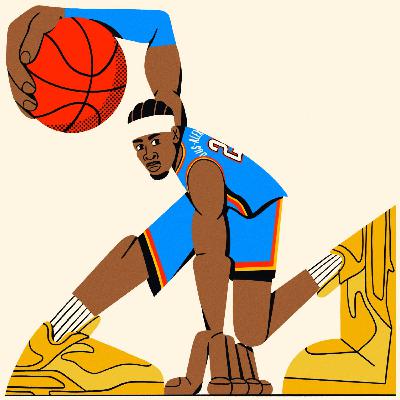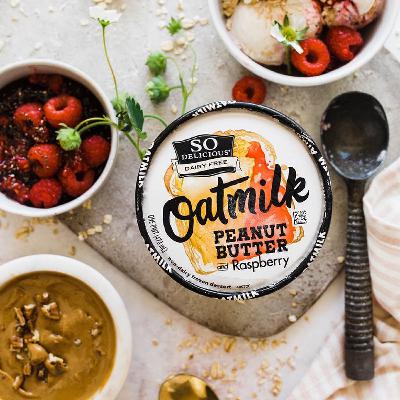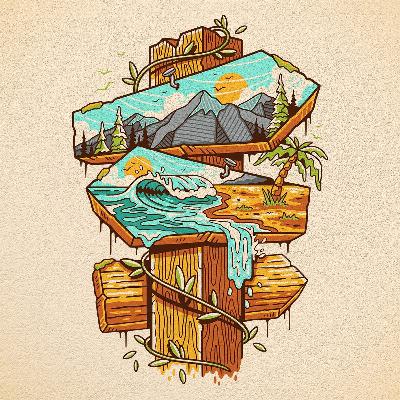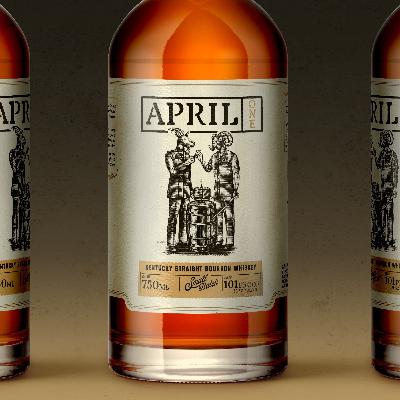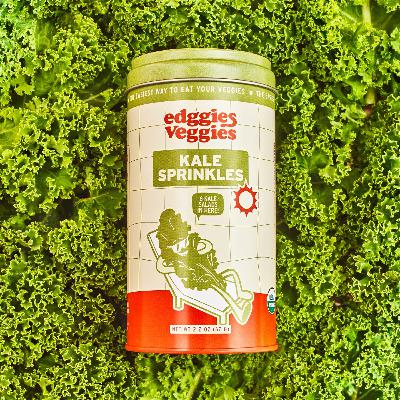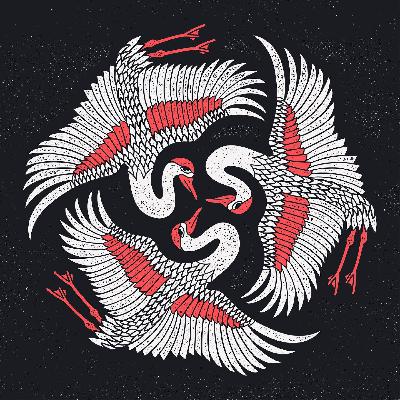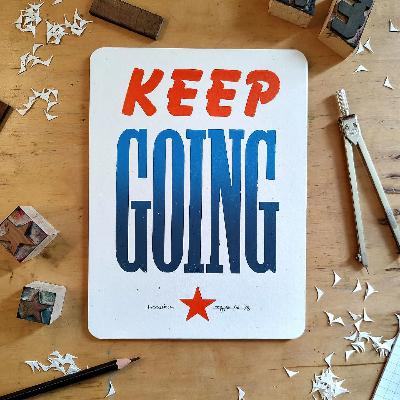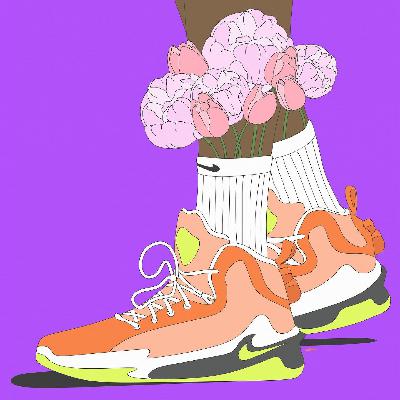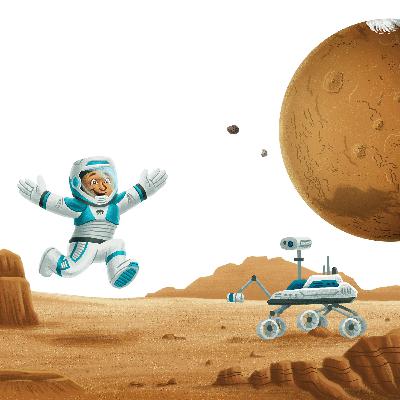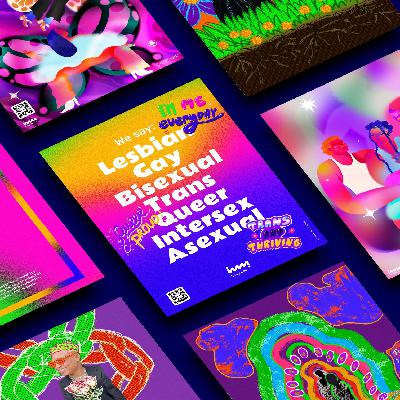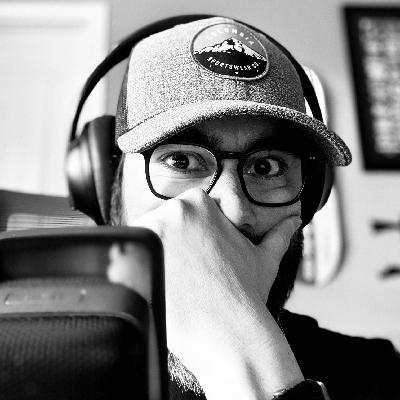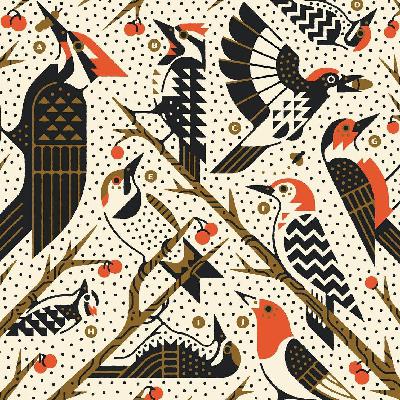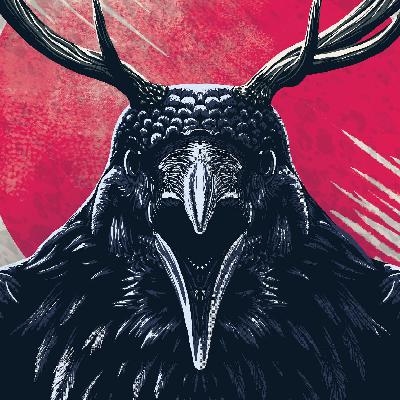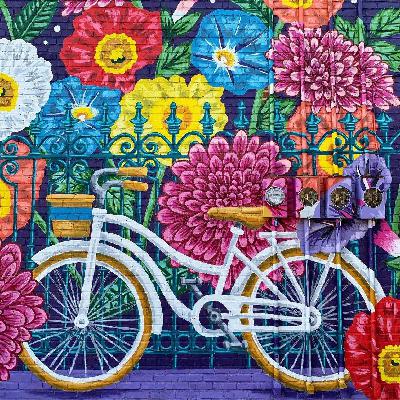Discover Students of Design
Students of Design

Students of Design
Author: Joseph Israel Raul Bullard
Subscribed: 4Played: 53Subscribe
Share
© 2024
Description
Students of Design is a graphic design podcast for students, young professionals, or anyone navigating the design industry. Hosted by Joseph Israel Raul Bullard, a Logo & Visual Identity Designer based in Colorado.
Join me as I interview industry professionals and work with them to decode the design industry, talk about what it takes to be successful, and hopefully answer some of those burning questions that all students have. Email your question to studentsofdesignpod@gmail.com.
Join me as I interview industry professionals and work with them to decode the design industry, talk about what it takes to be successful, and hopefully answer some of those burning questions that all students have. Email your question to studentsofdesignpod@gmail.com.
41 Episodes
Reverse
Jen is a Nashville-based independent type designer and resource creator for creative business owners. You might be familiar with some of her best-selling typefaces, like Perfectly Nineties, Editor's Note, and Founder's Hand. However, long before her formal education in type design from Type@Cooper, Jen got her start on Creative Market. She created and uploaded font after font, even though she didn't know the rules and guidelines of type design. The best part is IT WORKED, because people bought and used her fonts, and that was enough to inspire her to keep doing it. Surprisingly, Jen only wanted to make enough money to pay her water bill and eat at Chipotle once a week. But now, brands like Sprouts, Victoria's Secret, Kohl's, Bed Bath & Beyond, and Sweetgreen are using her typefaces. She's come a long way from wanting to be an orthopedic surgeon in Colorado; her love for type design has gone from hobby to career, and she's LITERALLY sold a digital product every single day of this year.Tune in for a talk about getting started on Creative Market, her struggles with tying her self-worth to her income, and finding the balance between making type that's accessible for everyone and becoming a world-class type foundry. Follow Jen on Instagram @jenwagnertype, and explore her typefaces on her website jenwagner.co. If you sign up for her email list, you'll get 20% off your first order!Questions for this interview.Which of these options do you think affects readability more: a combination of font size, leading, and line length, OR a combination of color, weight, and stroke contrast?Jen, who the hell do you think you are, thinking you could get accepted by Type@Cooper with no formal education in graphic design or typography?So, if you compare your designs from a few months before and after attending Type@Cooper, how did they change, and how are they better?Can you think of something you learned from being a type designer that you wouldn’t have learned otherwise, that is also something you believe every regular-ass graphic designer should know?How bad were the first 25 fonts you made and uploaded to Creative Market?If you knew just a little more about type design when you were getting started, do you think you would have gotten in your own way and held yourself back from releasing your first 25 fonts?What changed with Creative Market around 2021, and why did you feel it was the right time to explore different options?How many of the last 30 days would you say someone licensed a typeface or purchased any kind of digital product from you?You've struggled with your self-worth. Have you gained enough experience and confidence to grow out of that way of thinking, or do you still find yourself struggling with that perception of yourself?How difficult is it to balance making type that’s accessible for independent designers with a desire to be known as a world-class type foundry?How often do you design a typeface and think, “This is it,” this one’s gonna be my new best-seller, only to realize, nope, no one’s interested in buying it?Can you identify your typefaces immediately when you encounter them in the world? Have you ever come across a typeface you thought was yours but turned out to be someone else’s?
---If you LIKE what you hear, please subscribe and keep listening. Sharing this episode with someone is the best way to support the podcast. If you LOVE what you hear and want to help me keep the interviews coming—consider buying me a coffee on Ko-Fi.Also, I'm always looking for questions from listeners. If there's a burning question you want to hear answered on the podcast, please email it to me at studentsofdesignpod@gmail.com.Follow @studentsofdesignpod on Instagram for updates, episode drops, and behind-the-scenes content.The music you hear on the podcast is Accident by Timothy Infinite and PUSH !T by Nbhd Nick.studentsofdesign.simplecast.com
James is an author, type designer, and the founder of OHno Type Company, a digital type foundry based in San Jose, California. You might license some of his wildly imaginative fonts, including Beastly, Ohno Fatface, Degular, Polymath, Regrets, Obviously, and Hobeaux. Before he got his start in the bowels of graphic design, James studied design at California College of the Arts. Then he learned how to cast typographic spells while attending the Hogwarts of type design, AKA Type Media at the Royal Academy of the Arts in The Hague, Netherlands. James is also an educator and a podcaster—check out his podcast, Ohno Radio—and swears that Canson marker paper is holy in the world of sketching. If you geek out over naming, you'll be excited to learn that James almost named his foundry "The Spaghetti Factory" or "The American International Type Company." I don't know how to make those options make sense, but hey, man, back OFF, Life's a Thrill, and Fonts Are Chill.Tune in for a talk about James's number one rule of letterspacing, his father's love for toasters, and the dominance of low-contrast sans-serif typefaces. Follow James on Instagram @ohnotypeco, purchase his fonts on his website ohnotype.co, or add them on Adobe Fonts, and read this blog post if you want to get started in type design. THEN, read his book, The Ohno Book: A Serious Guide to Irreverent Type Design, to level up even more.Questions for this interview.Why do you design a specific set of characters before others, and how does that make you more efficient as a type designer?Can you explain the “Counterspace Equals Letterspace Technique,” also known as your “Rule #1 of Spacing?”Another technique is something you call “Three at a time.” Why three, and what do you mean by that?Which of these do you think is less important? Spacing or drawing good vectors?Why shouldn’t someone digitize their letterform sketches in Adobe Illustrator, and what makes applications like RoboFont and Glyphs so much better?Can you tell us what you learned from Jesse Ragan and his process for vectorizing a typeface called Showcard Stunt?Your father was an English teacher for 40 years. What did he say he should have been instead?Do you think you’re following your passion in the way your father didn’t follow his?What you do as a type designer is very specialized. Have you ever felt like you backed yourself into a corner or regretted not becoming a more well-rounded designer?Selling fonts on your website generates around 50% of Ohno's revenue, and Adobe Fonts accounts for another 40%. Is this still accurate? Can you explain how Adobe tracks sales and how that works?Why wouldn’t a type foundry choose to distribute with Adobe Fonts?How do you decide which ideas to pursue and actually turn into digital fonts?You recently released a book called The Ohno Book: A Serious Guide to Irreverent Type Design. Who’s it for? What’s inside it? What are we gonna learn by reading it?
---If you LIKE what you hear, please subscribe and keep listening. Sharing this episode with someone is the best way to support the podcast. If you LOVE what you hear and want to help me keep the interviews coming—consider buying me a coffee on Ko-Fi.Also, I'm always looking for questions from listeners. If there's a burning question you want to hear answered on the podcast, please email it to me at studentsofdesignpod@gmail.com.Follow @studentsofdesignpod on Instagram for updates, episode drops, and behind-the-scenes content.The music you hear on the podcast is Accident by Timothy Infinite and PUSH !T by Nbhd Nick.studentsofdesign.simplecast.com
Maya is an author and multi-hyphenate creative leader based in the San Fransico Bay Area, specializing in art direction, brand design, and illustration. Today, she's a Brand Design Lead at Yahoo, but she also worked at Lyft, Asana, and Square. WAY before working at any of those places, she spent the weekends at her grandmother's playing Sonic the Hedgehog and drawing Powerpuff Girls and Sailor Moon. She's also obsessed with 80s, 90s, and early 2000s pop culture, and has an affinity for hard edges, shapes, color blocks, and vibrancy. Recently, and in response to the murder of George Floyd, Maya spent three years writing and illustrating her book called The Anti-Racist Vocab Guide: An Illustrated Introduction to Dismantling Anti-Blackness. An excellent resource to learn more about terms like assimilation, blackface, privilege, tokenism, and white supremacy.Tune in for a talk about her career as an in-house designer in the tech industry, showcasing culture in your work, how writing grounds and influences her visual directions, and the salad bowl theory. Follow Maya on Instagram @mayaealey, find brand design on her website mayaealey.com, and buy her book, The Anti-Racist Vocab Guide: An Illustrated Introduction to Dismantling Anti-Blackness, online.Questions for this interview.In general, how were you able to string together such a solid list of companies to work for? (And) Looking back, is there anything that you believe you did (really) well that helped you get those jobs?What would you say to a college student who’s hesitant to take an in-house job or a mid-career designer considering a transition from agency life? What’s waiting for them in the in-house world?If you had to start looking for a job tomorrow, what signs would you look for that tell you a company truly cares about creativity and design?You often start your process with words and emphasize writing over visuals. Why do you do that, and can you explain how that approach helps you shape your visual direction?What about the 80s, 90s, and early 2000s still speaks to you emotionally or visually?What advice would you give someone who wants to showcase culture in their work but doesn’t quite know how to incorporate it?Your mother emphasized the importance of your education and self-sufficiency. How have those ideas influenced your creative career over time?Can you give us some context behind why your book exists, what it’s a response to, and what you hope people take away from reading it?How did you balance clarity with depth, especially when simplifying terms that carry so much history and weight?Can you help us understand the difference between the salad bowl and melting pot theories?Suppose someone’s in the middle of an interview process and they’re concerned about a company's commitment to diversity. What can they do to figure out how important diversity is to the company they’re interviewing with? Or what would you do?What have the most inclusive environments done well to make you feel seen and supported?Are you still holding yourself back? Are you still on the journey to authenticity?
---If you LIKE what you hear, please subscribe and keep listening. Sharing this episode with someone is the best way to support the podcast. If you LOVE what you hear and want to help me keep the interviews coming—consider buying me a coffee on Ko-Fi.Also, I'm always looking for questions from listeners. If there's a burning question you want to hear answered on the podcast, please email it to me at studentsofdesignpod@gmail.com.Follow @studentsofdesignpod on Instagram for updates, episode drops, and behind-the-scenes content.The music you hear on the podcast is Accident by Timothy Infinite and PUSH !T by Nbhd Nick.studentsofdesign.simplecast.com
Olga is a Ukrainian-born and New Jersey-based muralist and lettering artist. Thanks to her godfather, she began painting at the age of six and has been an artist ever since. She has created artwork for notable clients, including Crayola, Snapchat, Tillamook, Coca-Cola, Trader Joe's, and others. Olga spent nearly a decade working in the magazine industry, and she reviewed a lot of resumes during that time. One time, someone's father called Olga to ask why she hadn't hired his daughter for a job opening. YIKES! After branching out on her own, and after hundreds of murals and lettering projects, she has a basement full of paint and way too many pens and pencils to know what to do with them. She's also a firm believer that Alphacolor makes the most buttery and saturated chalk you will ever find. Some of her book recommendations are "In Progress" by Jessica Hische, "The Lettering Manual" by House Industries, "The Power of Habit" by Charles Duhigg, and "The Body" by Bill Bryson. Once upon a time, she was afraid of dogs and highways, but has replaced those fears with a love for bunnies, hiking, and typography. Tune in for a talk about fundraising to support those affected by the invasion of Ukraine, how to use toothpicks, tweezers, and paintbrushes to refine food lettering compositions, and what to do when a client tells you to create whatever you want instead of giving you any type of direction. Follow Olga on Instagram @olgamuzician, and check out more of her work on her website: olgamuzician.com. If you're interested in learning how to make art with food and objects, you should take her tactile lettering class on Skillshare!Questions for this interview.Did you ever think lawn signs would help lead you to such a meaningful mural in your career?Regarding the invasion of Ukraine. How're you doing? How're you holding up overall? Can you share some of your feelings about what's happening over there?How did it feel to see your work take on that kind of public and emotional significance?Can you explain what tactile lettering is for anyone hearing that term for the first time?What's the most surprisingly cooperative food you've worked with, and which one made you want to quit halfway through?Can you walk us through how tools like tweezers, toothpicks, and a paintbrush help you refine food lettering compositions?How often do the foods you want to work with influence the words within a design? Or do you usually come up with the messaging first and then select the most appropriate foods to match those words?What went wrong when you tried to add the finishing coat to your hand-painted skateboard?You painted a challenging set of murals for HoneyStash. Could you elaborate on the challenges of that project and explain how the viewer's vantage point made it difficult to paint those murals?What questions do you think we should ask ourselves before agreeing to a project with a low budget? Or, in other words, how do you decide if it's worth it?Is your mural minimum still $3,500?How do you handle a client who doesn't have a clue what they actually want and just tells you to do whatever you want to do?What made you feel successful, or what would make you feel that way? Is it a particular income amount? Is it a specific type of work or a specific client? Is it something else?
---If you LIKE what you hear, please subscribe and keep listening. Sharing this episode with someone is the best way to support the podcast. If you LOVE what you hear and want to help me keep the interviews coming—consider buying me a coffee on Ko-Fi.Also, I'm always looking for questions from listeners. If there's a burning question you want to hear answered on the podcast, please email it to me at studentsofdesignpod@gmail.com.Follow @studentsofdesignpod on Instagram for updates, episode drops, and behind-the-scenes content.The music you hear on the podcast is Accident by Timothy Infinite and PUSH !T by Nbhd Nick.studentsofdesign.simplecast.com
Kory is the Creative Director and Founder of Park St Studio, a design studio based in Phoenix, Arizona. His wife, Kasey, is also his business partner, and she played a significant role in establishing the processes and practices that streamline the studio's operations. They have a great story of how they met, and together, they've worked with apparel brands, breweries, coffee shops, and the Phoenix Suns, among others. Their focus is on branding, packaging, merchandise, and custom illustrations, and Kory's come a long way since his childhood days of spray painting on particle board in his backyard. He's a fan of DKNG, David Walker, Benny Gold, I Am Sloth, and Wacom products, and he would love to have dinner with Ellen DeGeneres because he thinks she's hilarious. Here's his favorite quote: "Success is not the key to happiness. Happiness is the key to success. If you love what you are doing, you will be successful."Tune in for a talk about taking your design business to the next level with a CRM, learn precisely when he talks to his clients about how much money they should pay him, and he breaks down how he handles discouraging feedback without losing his confidence. Follow Kory on Instagram @korymiller and his studio @parkststudio. You'll find more of his work on his website: parkststudio.com. Party on!Questions for this interview.Can you explain what Kasey does for the studio, talk about her expertise, and describe how her skills complement yours?Eventually, Kasey stepped away from her job to devote all of her energy to Park St Studio. What was that transition like for both of you? Was it stressful, exciting? How do you remember feeling?How do you interact with clients so they feel like you're a part of their team, rather than just a person they've hired to create something for them?How did you feel when you realized you weren't the only person who didn't have it all figured out?What is it about the way you approach those conversations, and why do you think clients feel comfortable with the thought of working with you?How quickly and at which point in the process do you start discussing money if the client doesn't bring it up first?What advice would you give to someone trying to determine the value of their work?Is there a process, a technique, or an approach you've picked up from another studio or agency that has helped you run your business more efficiently and better overall?So, when a client lets you know you've missed the mark, how do you process discouraging feedback without letting it shake your confidence?You painted a mural in the middle of an active construction site. What was that experience like, and what was your biggest takeaway from it?Can you explain how your use of Instagram has evolved, and also touch on how you've used the search feature, hashtags, and other accounts to help you find new people to work with?
---If you LIKE what you hear, please subscribe and keep listening. Sharing this episode with someone is the best way to support the podcast. If you LOVE what you hear and want to help me keep the interviews coming—consider buying me a coffee on Ko-Fi.Also, I'm always looking for questions from listeners. If there's a burning question you want to hear answered on the podcast, please email it to me at studentsofdesignpod@gmail.com.Follow @studentsofdesignpod on Instagram for updates, episode drops, and behind-the-scenes content.The music you hear on the podcast is Accident by Timothy Infinite and PUSH !T by Nbhd Nick.studentsofdesign.simplecast.com
Nathan is a seasoned Illustrator, Artist, and Designer living in Austin, TX, and surprisingly, we never crossed paths while I was living in Austin. But I bet we were in the same place at the same time and never even realized it. His artwork draws inspiration from urban culture, graffiti, street fashion, and sports. At the same time, his use of texture and exaggerated character features adds a gritty New York City vibe to his illustrations. Nathan's list of clients includes the NBA, NFL, New Balance, Under Armour, Nike, Timberland, and other well-known brands. Besides reminiscing about cartoons from the '80s and '90s or classic G.I. Joe packaging, he enjoys sitting down for a meal at Jeffrey's Grocery. He's also the only person I know who has participated in a 4-hour design competition on YouTube for a chance to win $10,000.Tune in for a talk about why he was afraid to label himself as an illustrator early on in his career, why a part of him belongs to New York City, and how he almost derailed a design competition by asking to use the restroom, lol. Follow Nathan on Instagram @atpcdesign and check out more of his work on his website: alltheprettycolors.com. Also, "Don't Never Not Give Up".Questions for this interview.Do you think most people have the perception that you're only an illustrator, and do you feel like the rest of your skills are underrecognized?Having lived in Dallas for a bit, is any part of you a Dallas Cowboys fan?You've created artwork for the Dallas Mavericks. Can you explain how you got your foot in the door with the Mavs and describe what you made for them?When illustrating basketball players, how do you decide which details to emphasize to make a player recognizable?How do you break down movements like a crossover or a reverse layup into something static yet still dynamic in your illustrations?What is it about New York City that captures your attention, and how does the city influence you?Could you explain the concept behind the Trio of Time series, and then tell us about the inspiration behind the idea for your timepiece?Did that project teach you anything new, and what challenges did you encounter when designing for such a small mechanical footprint?You were on a design competition show called Card Stars. What did you know and what didn't you know about the competition before it started?Was the competition the first time you've ever sat down to create within such a strict, uninterrupted block of time?How stressful was the experience of working within a strict time limit on your slow-ass laptop, with cameras rolling, people shuffling around, and the weight of trying to do your best work for a chance to win 10,000 dollars?Making your family proud was essential to you. Do you feel like you did that?Which collaboration felt the most like a true reflection of your own voice as an artist, and why?
---If you LIKE what you hear, please subscribe and keep listening. Sharing this episode with someone is the best way to support the podcast. If you LOVE what you hear and want to help me keep the interviews coming—consider buying me a coffee on Ko-Fi.Also, I'm always looking for questions from listeners. If there's a burning question you want to hear answered on the podcast, please email it to me at studentsofdesignpod@gmail.com.Follow @studentsofdesignpod on Instagram for updates, episode drops, and behind-the-scenes content.The music you hear on the podcast is Accident by Timothy Infinite and PUSH !T by Nbhd Nick.studentsofdesign.simplecast.com
Adam is the Principal and Creative Director of Vicarel Studios, an artful branding and graphic design studio in Denver, Colorado. He loves avocados, even though he was willing to cut them (and feta) out of his diet early on in his career to be more frugal. RESPECT. Adam has worked with notable clients like NBC, lululemon, New Belgium Brewing, SYFY, and Native Roots Cannabis Co., and he believes "If you're thinking about doing a thing, you probably should have already done it." We hung out in Austin earlier this year, had some drinks, I told him about the biological father I can't find, and then he snuck off to the restroom to take a sip of whiskey from his flask—frugal. I'm kidding, the flask part didn't happen, but it's 100% believable. One of my favorite questions I asked him in this interview was about how our work expands to fill the available time we allot it.Tune in for a talk about four near-death experiences in four years, why he rebranded and repositioned his studio in 2020, and the most significant amount of money he billed for a single project. Follow Adam on Instagram @adamvicarel, connect with him on LinkedIn, and subscribe to his almost weekly newsletter at vicarelstudios.com/newsletter. Yeah, dawgie!Questions for this interview.Can you tell us why someone held you up at gunpoint and how you felt in that moment?You were involved in a car wreck. How would you rate the safety of your 2019 Kia?Could you explain Parkinson's Law and share your thoughts on it?There was a time you described your work as an artful implementation of strategic design. Why did you decide that wasn't working, and how have you refined the way you talk about your studio since then?Can you share why you felt the need to rebrand in the first place and what your objectives were in trying to reposition yourself?Which templates or practices would you implement sooner if you could go back in time?If you think back on your life and your career, what are some of the reasons you were resistant to taking action?What's the budget or dollar range you hope a majority of the projects you accept fall within?How fearful have you been that you'll present finished ideas to a client and they respond in a way that makes you believe they feel like they're not getting their money's worth?Will you share the most money you've made on a single project?What does the phrase "chasing the fog" mean to you?Why do you view perfectionism as a form of procrastination and ultimately an excuse that many creatives use?Can you think of a time when giving first (without expectations) came back to you in an unexpected way?Can you tell the story of how you fucked up on The Real Housewives of Dallas, and talk about what you wanted to do on the show, but you didn't do?
---If you LIKE what you hear, please subscribe and keep listening. Sharing this episode with someone is the best way to support the podcast. If you LOVE what you hear and want to help me keep the interviews coming—consider buying me a coffee on Ko-Fi.Also, I'm always looking for questions from listeners. If there's a burning question you want to hear answered on the podcast, please email it to me at studentsofdesignpod@gmail.com.Follow @studentsofdesignpod on Instagram for updates, episode drops, and behind-the-scenes content.The music you hear on the podcast is Accident by Timothy Infinite and PUSH !T by Nbhd Nick.studentsofdesign.simplecast.com
Brooks is a SoCal-born and Colorado-raised Independent Designer and Illustrator based in Denver. For the past 10(ish) years, he's been the driving force behind Nowhere Land, an outdoor and adventure-inspired apparel brand and design shop. You can recognize his work by its bold colors and stylized landscapes that transform into the shapes of animals.I met Brooks this year (2025) at Crop Conference in Austin, TX, while we were reviewing student portfolios, and we almost got into a fender bender on our way to Via 313 for lunch. Luckily, the other driver recognized Brooks as the Skatepark Gremlin, and everyone calmed the hell down. Lol, I made that part up. We didn't talk about this, but I love how the compositions of his designs remind me of tattoos. However, something we DID discuss was what it was like for him to live and work out of his RV full-time. Tune in for a talk about reaching milestones by setting smaller goals, how he shifts his perspective when he realizes he's complaining about working for himself, and some insight into his process for making color palettes. Follow Brooks on Instagram @nowherelandsupply and consider sketching in the color pink, because Brooks does, and because it works.Questions for this interview.You're great at many things. What do you think you don't do so well?What was it like working for yourself full-time out of an RV?I'm pretty sure Starlink wasn't around in 2016, so how did you access the internet when you needed it?You thought you would work for The Duck Company forever. Why did you think that, and why didn't you stay there forever?You said you would rather struggle working for yourself than for somebody else. Five years later, do you still feel the same way in 2025?Can you explain what the phrase "short steps, long vision" means to you?When you find yourself complaining about working independently, what perspective or mindset helps you step back and appreciate the freedom that working for yourself offers?Baseball was your life until 19 or 20—how did the shift away from pursuing pro baseball open the door to art and design for you?What kind of inspiration and techniques have you pulled from different designers and illustrators?Do you still use a combination of Photoshop and Illustrator for your illustrations? If so, how do you split the work between those two applications for a typical project?How often do you lose work because of Photoshop or Illustrator crashing? Is it easy for you to remember to save frequently, or do you still get caught off guard?How much direction from a client do you need to feel comfortable getting started, and how do you push back when a client says "do whatever you want"?Can you walk us through where you like to sample colors from, or where you look for inspiration?How have the compositions of your illustrations improved over the years?The 10th anniversary of Nowhere Land is in 2026. What does that mean for you, and how does it make you feel?
---If you LIKE what you hear, please subscribe and keep listening. Sharing this episode with someone is the best way to support the podcast. If you LOVE what you hear and want to help me keep the interviews coming—consider buying me a coffee on Ko-Fi.Also, I'm always looking for questions from listeners. If there's a burning question you want to hear answered on the podcast, please email it to me at studentsofdesignpod@gmail.com.Follow @studentsofdesignpod on Instagram for updates, episode drops, and behind-the-scenes content.The music you hear on the podcast is Accident by Timothy Infinite and PUSH !T by Nbhd Nick.studentsofdesign.simplecast.com
Andrew is an Independent Designer in Colorado Springs who runs a studio called Impossibly Awesome Design Co. He specializes in logo and brand identity design, packaging, and illustration. Many of you know him from attending Crop Conference, and if you've been to The Springs within the past few years and had a beer at Bristol Brewing, you probably came across his work.I met Drew on October 15, 2022. Trust me, I found the calendar invite for our very first coffee hangout shortly after I moved to Colorado, and he's a big reason I was able to get involved in the local design community so quickly. Drew was also on my original shortlist of potential guests for this podcast, so interviewing him has been a long time coming. If you hang out with him long enough, you'll start to learn things about competitive volleyball, bourbon, the Rubik's Cube, and The War of Art by Steven Pressfield. One of the most fascinating things about Drew's creative journey is that he's completely self-taught. He didn't attend school for design, but he does hold degrees in marketing and finance. Finance? Yeah, finance.Tune in for a talk about the pros and cons of being a self-taught graphic designer, curating his (own) design curriculum, cherry-picking the best ideas from the people he admires, and tips for getting started on a project when starting doesn't feel impossibly awesome. Follow Drew on Instagram @impossiblyawesomedesign, and check out his portfolio website: impossiblyawesome.design.Questions for this interview.Why was the Bristol Brewing project the one that helped you feel like a true professional?You asked Nick Longo for help on that project. What kind of help were you looking for, and what advice did Nick give you?What kind of impact has Colin Christie made on your design career?What gaps or challenges have you encountered as a self-taught designer that you think could have been addressed in design school?How has being self-taught helped you as a designer? In other words, what are the advantages of being self-taught?Were there times when you seriously considered enrolling in a formal design program? What ultimately kept you on the self-taught track?How do you like to invest in yourself, and what are some examples of things you've spent money on to help you level up?Have you ever purchased a design course or a resource and felt like you didn't get your money's worth?Did you do anything differently this year in preparation for the Crop Conference or during the event compared to previous years?Do you remember which presentation at Crop was your favorite?Do you find it challenging to stay creative and consistently generate great ideas?Do you think working in-house or at an agency full-time would make it easier to stay creatively locked in, or do you think it would be even more challenging?When did it finally sink in for you that you can say no to the projects you're not super excited about?Do you have any tips for getting started on a project when you're feeling overwhelmed?Why is The War of Art by Steven Pressfield worth reading, and how can it help us break through creative barriers?Since getting married recently, is there a possibility that combining your incomes could expedite your decision to leave your day job and focus on Impossibly Awesome Design Co. full-time?
---If you LIKE what you hear, please subscribe and keep listening. Sharing this episode with someone is the best way to support the podcast. If you LOVE what you hear and want to help me keep the interviews coming—consider buying me a coffee on Ko-Fi.Also, I'm always looking for questions from listeners. If there's a burning question you want to hear answered on the podcast, please email it to me at studentsofdesignpod@gmail.com.Follow @studentsofdesignpod on Instagram for updates, episode drops, and behind-the-scenes content.The music you hear on the podcast is Accident by Timothy Infinite and PUSH !T by Nbhd Nick.studentsofdesign.simplecast.com
Marisa is a Chicana woman and the Creative Director behind If Only Creative, a Bay Area creative studio she founded in 2022. Her studio offers brand identity and packaging design, social media strategy and management, content creation, and trend-setting commercial photography. After serving ice cream, burgers, and coffee, and changing her major three times in college, Marisa attended the University of Huddersfield—which she claims is an amazing place, but I don't believe her—and earned a degree in Marketing. After living in England for seven years, holding roles at creative agencies and breweries, and spending thousands of hours listening to Miley Cyrus, she moved back to sunny California to focus on working with women- and POC-owned businesses that are impact-driven. Along the way, Marisa turned her frustrations surrounding the way people celebrate Cinco de Mayo into a special dinner series highlighting and honoring the ingredients and flavors found in Puebla, Mexico, called El Otro Lado.Tune in for a talk about her connection to the food and beverage industry, the effects of defining your core values, and how forming an advisory board of creative people she trusts has helped her grow her business. Follow Marisa on Instagram @ifonlycreative, and check out the delicious-looking work on her website: ifonly-creative.com.Questions for this interview.First things first. Have you met Miley Cyrus yet?What was your childhood like, and what can you tell us about how you grew up?Why did you pivot away from saying "Latina-owned" and start saying "Chicana-owned," and can you talk about the nuances of that decision?IF you consider your career, are you finally doing what your heart tells you you should be doing?Why does the food & beverage industry have such a firm grip on you, and why does your passion thrive in that industry?How did defining your core values provide clarity and direction for your creative work and your business goals?How do you check yourself to ensure that your approach to a client project is grounded in authenticity for both you and your client?How can you quickly tell if a client is more interested in the community or the competition?What does the phrase "impact-driven" mean to you, and can you give us an example of an impact-driven client you've worked with and how they make an impact in the world?Could you explain what El Otro Lado is and provide a better understanding of what frustrated you when you came up with the concept?What is your ultimate goal for the event, and what do you hope people who attend one of the dinners will take away from the experience?What are you looking for, and what are some essential qualities a designer needs to showcase when you're searching for someone to partner with on a project?Why did you create an advisory board, and how does it help you grow as a business owner?How did you discover you were charging at least four times less than the amount you should have been charging for your services?What can you do differently that you believe would make you a better leader?
---If you LIKE what you hear, please subscribe and keep listening. Sharing this episode with someone is the best way to support the podcast. If you LOVE what you hear and want to help me keep the interviews coming—consider buying me a coffee on Ko-Fi.Also, I'm always looking for questions from listeners. If there's a burning question you want to hear answered on the podcast, please email it to me at studentsofdesignpod@gmail.com.Follow @studentsofdesignpod on Instagram for updates, episode drops, and behind-the-scenes content.The music you hear on the podcast is Accident by Timothy Infinite and PUSH !T by Nbhd Nick.studentsofdesign.simplecast.com
Nicholas—Nick—is a Graphic Designer and founder of Miner Design Co., located near Baton Rouge, Louisiana. He specializes in identity design, illustration, and packaging design, and works with restaurants, food and beverage companies, hospitality, and retail clients. Embracing discomfort has been a recurring theme throughout Nick's life, and much of his work ethic stems from his experiences living with his grandfather. He's a firm believer in "People Over Projects," and building relationships with his clients is more important than the dollar amount tied to each project. But, don't get it twisted, Nick's just like us. When he was younger, he wanted to build things with K'NEX for a living. He has a bookshelf full of design books that he doesn't reference often enough, he sent a job to print with a watermarked Shutterstock image in the layout, and he worries about where his next client will come from.Tune in for a talk about running his business, screwing up his taxes, and good old fashioned printed self-promotion pieces. Follow Nick on Instagram @minderdesignco, connect with him on LinkedIn, and see award-winning work on his website: minerdesignco.com.Questions for this interview.What does the phrase "People Over Projects" mean to you?Have you ever had a client demand a refund during a project?What conversation do you have with yourself, and how do you reframe rejection when a pitch or one of your proposals gets turned down or maybe even ignored?Would you recommend a troublesome client to a close design friend? How would you handle that situation? Is it something you've run into before?Your grandfather once said, "There may be men out there stronger or smarter than me, but nobody is going to outwork me." How do these words shape you and Miner Design Co.?Do you struggle to find balance between honoring that work ethic and knowing when to step back?Can you tell us the story of how your grandmother helped you redefine how you were marketing yourself and how she helped you get a job after graduation from LSU?You had a rough and uncomfortable childhood, and you moved seven times in high school. How did that volatility shape your ability to adapt and persevere in your career today?Surprisingly, you left your full-time agency job when your daughter was born. Why did you make that decision, and how did you and Katie prepare financially and emotionally for that transition?Have you ever made a mistake with your taxes?What was your biggest "aha" moment in your first year after going all in on Miner Design Co.?What part of the business still intimidates you in 2025?You recently posted a video on Instagram about your latest self-promotion piece. Can you talk about how it works, who you're sending it to, its versatility, and the cost of producing each one?
---If you LIKE what you hear, please subscribe and keep listening. Sharing this episode with someone is the best way to support the podcast. If you LOVE what you hear and want to help me keep the interviews coming—consider buying me a coffee on Ko-Fi.Also, I'm always looking for questions from listeners. If there's a burning question you want to hear answered on the podcast, please email it to me at studentsofdesignpod@gmail.com.Follow @studentsofdesignpod on Instagram for updates, episode drops, and behind-the-scenes content.The music you hear on the podcast is Accident by Timothy Infinite and PUSH !T by Nbhd Nick.studentsofdesign.simplecast.com
Daniel is a dad, designer, and speaker who specializes in letterpress design and printing. After 14 years, he lost his career in 2020, so his family relocated back to the 5th-generation farmland he grew up on in rural Indiana. There, his growing interest in typography turned into a small letterpress studio called Hoosier Type Company. Daniel does everything. He sources antique wood type, carves new letterforms when he can't find what he needs, and creates prints of his designs, which he eventually sells on Etsy—from the same garage where his grandfather used to paint. Also, all of his designs are handcrafted in small batches and proudly made in the Midwest.Tune in for a talk about wood fonts and their measurements, locking up a design on his flatbed letterpress, and how working with antique materials comes with compromise. Follow Daniel on Instagram @hoosiertype.co, buy one of his prints on Etsy, or book him for a type talk or workshop on his website.Ink, Paper, Sweat, & Hope.Questions for this interview.Does speaking to an audience about your career and what you do become a bigger part of your journey?You're introducing a new wood font to your collection. Can you explain what you're doing to those blocks and why you're treating them before you print some proofs?Can you help us understand what terms like '8-line', '10-line', or '15-line' mean?What does the term "scheme" mean in the context of wood type?Why would you want multiple blocks of certain letters in a wood font?Can you explain why the "type high" measurement is essential and the exact measurement you're looking for?Can you tell us what else is inside a chase besides the wood type?How do you make sure the placement of woodblocks is level, straight, and aligned?How do you explore ideas with digital fonts before setting wood type?When you create digitally, and the final output will not be letterpressed, what specific features or characters do you look for in a font or font family?Do you think good typographic taste is something that can be taught and learned?What are some of the compromises you make with letterpress, and how do they influence your designs?Why should people care about wood type? How can the everyday average designer benefit from learning about letterpress design and printing?
---If you LIKE what you hear, please subscribe and keep listening. Sharing this episode with someone is the best way to support the podcast. If you LOVE what you hear and want to help me keep the interviews coming—consider buying me a coffee on Ko-Fi.Also, I'm always looking for questions from listeners. If there's a burning question you want to hear answered on the podcast, please email it to me at studentsofdesignpod@gmail.com.Follow @studentsofdesignpod on Instagram for updates, episode drops, and behind-the-scenes content.The music you hear on the podcast is Accident by Timothy Infinite and PUSH !T by Nbhd Nick.studentsofdesign.simplecast.com
Fiorella—or Fio—is a designer, illustrator, and content creator from Lima, Peru, living in Toronto, Ontario. She's a lifelong basketball player, so it's no surprise she's worked with organizations and sports brands like the WNBA, NBA, NFL, PWHL, and Asics. Not only was Fio named MVP of her high school basketball team TWICE, but she also played guard for the University of Toronto, and her mother played for Peru's Women's National Team. So, yeah, basketball (literally) flows through her veins. Fiorella has always been passionate about blending the intersections of design and sports, and she's on a mission to find meaningful work that allows her to share that passion with women around the world.Tune in for a talk about designing Canada's first outdoor WNBA court, why she left the world of architecture, and putting yourself out there on social media. Follow Fio on Instagram @fiorelladoodles, connect with her on LinkedIn, and see more of her work on her website, fiorellagranda.myportfolio.com.Questions for this interview.When people ask you about your visual style, how do you like to describe it?Before designing Canada's first outdoor WNBA court, what was going through your mind, and what were you struggling with?How did you feel when you learned the WNBA was going to play its first game on Canadian soil in 2023?Transitioning from architecture, what was missing from your life at that time, and was there a catalyst that convinced you to pursue graphic design and illustration full-time?How does your online presence benefit from appearing alongside your artwork?What's your advice for someone who wants to build their brand or business like you, but they're holding themselves back because they're intimidated by the idea of being face-forward on their social channels?Have you ever felt like what you're doing on Instagram and TikTok is cringeworthy?Is there a silver lining when you pitch ideas to big brands, even when you don't hear back from them?How do you feel when you notice someone on Instagram or TikTok is doing the same thing you're doing, and their videos are taking off, but yours aren't?You adopted a Why Not Me mindset. How and when has that way of thinking helped you in your career?How have people you look up to in the creative community helped you get to where you are today?If you consider your professional experience, your cultural background, and your strengths and weaknesses, what do you believe gives you an edge?
---If you LIKE what you hear, please subscribe and keep listening. Sharing this episode with someone is the best way to support the podcast. If you LOVE what you hear and want to help me keep the interviews coming—consider buying me a coffee on Ko-Fi.Also, I'm always looking for questions from listeners. If there's a burning question you want to hear answered on the podcast, please email it to me at studentsofdesignpod@gmail.com.Follow @studentsofdesignpod on Instagram for updates, episode drops, and behind-the-scenes content.The music you hear on the podcast is Accident by Timothy Infinite and PUSH !T by Nbhd Nick.studentsofdesign.simplecast.com
Josh is an art director, illustrator, and author in Colorado Springs, Colorado. He's a sucker for LEGO minifigures and thought he'd never get a chance to illustrate a Little Golden Book—until he worked on four of them for LEGO! Josh has also worked with Scholastic, Highlights for Children, Discovery Education, Orion Telescopes and Binoculars, and other EdTech companies. He's spoken on stages like Creative South and ICON: The Illustration Conference and knows a thing or two about classic cartoons like Loony Tunes, Tom and Jerry, and Popeye. One of the most fascinating parts of his story is the parallels with his great-great-grandfather, Von G. It turns out that writing and illustrating kids' books is (literally) part of his DNA.Tune in for a talk about exploring his ancestry, being strategic with personal projects, and the difficulty of bringing LEGO minifigures to life in a kids' book. Follow Josh on Instagram @joshjlewis and LinkedIn, and see more of his work on his website joshjlewis.com and Dribbble.Questions for this interview.How do you approach giving constructive feedback to someone early in their career?Which do you weigh more heavily, concept and process, or execution and craft?Have you ever received a review that changed your feelings about your work?Would you be an author and illustrator of kids' books if you had never had children?How and when did you learn so much about classic cartoons?How did you discover Oscar Hunt Von Gottschalck is your great-great-grandfather? Was that information passed down to you by your mother, or did you find it yourself?Is Von G the oldest ancestor you've uncovered in your family tree?How did it make you feel to learn about your great-great-grandfather?Can you explain the idea behind Bite-Sized Books?How does treating a personal project like a real project help you, and how can someone do that for themselves?Which do you want to learn how to be the most? A pirate, a knight, a unicorn, or a ghost?Do you remember how you felt when asked to illustrate your first Little Golden Book?How difficult was bringing LEGO plastic minifigs to life in those books? Especially their expressions.What kind of feedback have you gotten about your book, Ray's Big Day?What makes a good picture book? What should it have, and what does it need to do?
---If you LIKE what you hear, please subscribe and keep listening. Sharing this episode with someone is the best way to support the podcast. If you LOVE what you hear and want to help me keep the interviews coming—consider buying me a coffee on Ko-Fi.Also, I'm always looking for questions from listeners. If there's a burning question you want to hear answered on the podcast, please email it to me at studentsofdesignpod@gmail.com.Follow @studentsofdesignpod on Instagram for updates, episode drops, and behind-the-scenes content.The music you hear on the podcast is Accident by Timothy Infinite and PUSH !T by Nbhd Nick.studentsofdesign.simplecast.com
Rebecca (she/her) is a queer woman of color born in Trinidad and Tobago. She's the Creative Director of Planthouse Studio, a queer-owned design studio built on the foundations of collaboration, inclusivity, and growth, dedicated to growing good things with good people. Bex is also the co-founder of Queer Design Club, the hub for LGBTQ+ creativity, and until recently, the Design Director at Ghost Note Agency. Some of my favorite works in her portfolio are for Hip Hop Caucus and the Center for Journalism & Democracy at Howard University, and she's also worked with the Obama Foundation Democracy Forum, Smithsonian's Anacostia Community Museum, Grammarly, and many more. Bex loves dim sum, Coca-Cola, Scrabble (like, on a competitive level), lives by the phrase "Be Good," and Maurice Cherry, Antionette Carroll, Debbie Millman, and Vanessa Newman inspire her.Tune in for a talk about building a community for creative people who identify as LGBTQ+, growing up in Trinidad and Tobago, and how we can all be better allies. Follow Bex on Instagram @beccabrooker, find more of her work on her website rebeccabrooker.com, and learn more about Queer Design Club and the Queer Design Count at queerdesign.club.Be Good.Questions for this interview.How can I, or anyone, make space for people to present themselves the way they perceive themselves?Can you briefly introduce us to Queer Design Club and explain what The Queer Design Count is?What message does the world need to hear right now?Can you share how growing up in Trinidad impacted your ability to discover your identity freely?Is it true that when you were 16, your parents sent you to speak with a nun after you came out to them?Queer Design Club has 1800+ members in its talent directory and over 5000 total members across 72 countries. How do these numbers make you feel?Can I get your thoughts on his quote from the 2019 Queer Design Count? "As a Black LGBTQ+ designer, I find the industry to be more welcoming to LGBTQ+ individuals than to Black designers."Can I get your thoughts on his quote from the 2019 Queer Design Count? "It's hard for me to tell if I have to fight harder because I'm a lesbian or if it's just because I'm female on a male-dominated team."What steps can cis-gendered, straight people take to view identity more fluidly?How do you apply the phrase "Be good" in your life?Can you suggest something we can work on to support people in design who identify as LGBTQ+?
---If you LIKE what you hear, please subscribe and keep listening. Sharing this episode with someone is the best way to support the podcast. If you LOVE what you hear and want to help me keep the interviews coming—consider buying me a coffee on Ko-Fi.Also, I'm always looking for questions from listeners. If there's a burning question you want to hear answered on the podcast, please email it to me at studentsofdesignpod@gmail.com.Follow @studentsofdesignpod on Instagram for updates, episode drops, and behind-the-scenes content.The music you hear on the podcast is Accident by Timothy Infinite and PUSH !T by Nbhd Nick.studentsofdesign.simplecast.com
Being open and transparent about my process is part of my DNA, so I want to bring you behind the mic and share some of the decisions that shape the tone and personality of this podcast. Small things about the show have changed throughout the first 25 episodes, but my intentions and the purpose of these interviews have stayed the same. It's still about inspiring people, helping them make fewer mistakes, and giving back to the creative community. Also, it's STILL a lot of work, lol, but it's also still a fulfilling and rewarding passion project to work on. Thanks for your support, and thanks for listening.Tune in for a talk about my podcasting guidelines, how I prepare for an interview, and a glimpse into the recording and editing process. Here's to the next 25!Cheers, y'all.
---If you LIKE what you hear, please subscribe and keep listening. Sharing this episode with someone is the best way to support the podcast. If you LOVE what you hear and want to help me keep the interviews coming—consider buying me a coffee on Ko-Fi.Also, I'm always looking for questions from listeners. If there's a burning question you want to hear answered on the podcast, please email it to me at studentsofdesignpod@gmail.com.Follow @studentsofdesignpod on Instagram for updates, episode drops, and behind-the-scenes content.The music you hear on the podcast is Accident by Timothy Infinite and PUSH !T by Nbhd Nick.studentsofdesign.simplecast.com
Erikas is a designer and illustrator who specializes in making playful geometric illustrations. He's also a boneheaded bird brain, and he knows it. Driven by his love for birds, he demands respect for pigeons, grackles, and sparrows, and he especially loves the Red-bellied woodpecker and the Scissor-tailed flycatcher. Originally from New York, Erikas has called Austin his home for the last decade and has created artwork for Austin FC, Half-Price Books, Oregon State Parks, Star Wars, HP, and many more. He's also been on the big stage and given presentations at Adobe Max and Creative Jam, and he will be a workshop leader at Design Ranch 2025. Erikas even has a course on Domestika—check it out here! Tune in for a talk about Dribbble shooting themselves in the foot, his fascination with birds, and why creating posters for Austin FC was so significant to him. Follow Erikas on Instagram @erik_as_erik, and check out fantastic artwork in his online shop.Questions for this interview.How do you feel about Dribbble's most recent Terms of Service update?Have you ever connected with a client on Dribbble and completed the entire project on their platform?Is being a Dribbble Pro member worth it?When did your fascination with birds start?Do you know what a Chicken-cat is?Which bird is most likely to be wrongfully accused of a crime?Why is Daytripper by Fabio Moon and Gabriel Ba one of your favorite books? What can you tell us about it?How did Matt Kaufenberg inspire you?Can you briefly summarize what you cover in your Domestika course?How much of the video production were you responsible for?Can you share some limitations within your artwork and how they help define your style?How do limitations tie into your Design Ranch workshop?You gave a presentation at St. Edwards University. What message were you trying to get across to those students?How did it feel to be invited to present at Adobe Max—one of the biggest design conferences in the world?You created a set of posters for Austin FC. Why was that opportunity so significant to you?Jolby hired you for an Oregon Parks & Recreation Department project. When did Jolby bring you into the mix?How confident are you that another designer can pick up where you left off and be successful with the style guide you created?You've painted on canvas, rocks, paint swatches, and wood. Do you have any ideas for what might be next?
---If you LIKE what you hear, please subscribe and keep listening. Sharing this episode with someone is the best way to support the podcast. If you LOVE what you hear and want to help me keep the interviews coming—consider buying me a coffee on Ko-Fi.Also, I'm always looking for questions from listeners. If there's a burning question you want to hear answered on the podcast, please email it to me at studentsofdesignpod@gmail.com.Follow @studentsofdesignpod on Instagram for updates, episode drops, and behind-the-scenes content.The music you hear on the podcast is Accident by Timothy Infinite and PUSH !T by Nbhd Nick.studentsofdesign.simplecast.com
Kilian is a Sacramento-based illustrator, designer, educator, and pixel wizard behind Great Raven Design Co. Take one look at his neck—you'll understand how much The Lords of the Rings means to him. I'm jealous of his Middle-earth-themed wedding a few years ago, but I think I could take him in a lightsaber duel. Kilian cut his teeth designing labels, t-shirts, and logos for the craft beer industry, and his artwork is ferocious and packed with intricate linework. If you have the coin, he'll draw mythical creatures, skeletons, and snakes until his eyes dry out. In addition to teaching Photoshop classes at Sacramento City College, he's a founding member of Tap in Creative Club and part of the "Sac Boys." Tune in for a talk about getting the most from a design conference, growing up in a family with two best-selling authors and a famous actor, and the turning point for his independent studio. Follow Kilian on Instagram @greatravendesignco and check out even more of his work on his website, greatravendesign.co. Live By The Lance.Questions for this interview.What went smoothly and what didn't go smoothly for the Fox of the Foothills mural you painted?Can you share your best tips for someone going to their first design conference this year?Have you set specific goals for the Crop Conference this year?How do you like to break the ice with people at a conference?What was difficult between 2018 and 2022? What challenges did you face?Did you struggle with undercharging for your work or have difficulty turning down projects with low budgets?What was your support system like while (you were) trying to get your foot in the door?Who won the lightsaber battle between you and Raylakin at Hunter and Erica's wedding?What convinced you to pursue illustration and design instead of a career in climbing?Who's a more impressive climber? Chris Sharma or Alex Honnold?Can you talk about the Tap in Creative Club and tell us how you got involved?What was it like growing up in your family?Has your mom's journey and perseverance impacted you and your career?Do you and your sister push each other creatively?(Do you know) what happens if you say "die a thousand deaths" when casting Scattercips?Was partnering with Burning Barrel Brewing Company a pivotal moment in your career?Is your hard work finally paying off?Do you still tie your self-worth to the success of your business?Do you find teaching at Sacramento City College rewarding?Who do you want to hear on the podcast?
---If you LIKE what you hear, please subscribe and keep listening. Sharing this episode with someone is the best way to support the podcast. If you LOVE what you hear and want to help me keep the interviews coming—consider buying me a coffee on Ko-Fi.Also, I'm always looking for questions from listeners. If there's a burning question you want to hear answered on the podcast, please email it to me at studentsofdesignpod@gmail.com.Follow @studentsofdesignpod on Instagram for updates, episode drops, and behind-the-scenes content.The music you hear on the podcast is Accident by Timothy Infinite and PUSH !T by Nbhd Nick.studentsofdesign.simplecast.com
Kirk is an illustrator, animator, and art director, and he runs a small independent studio called BoneHaus with his skeletal sidekick, Skully. Unlike most of us, he didn't go to art/design school, but that's a good thing because he probably wouldn't be doing what he does today if he had. Why? Kirk isn't good at drawing—a weakness he's turned into a superpower. He's an expert with shapes and great at breaking things down to their most basic forms to build them back up again through relatable details. His illustration style has attracted clients like Apple, Google, Adobe, Facebook, Amazon, Rocket League, Disney, and MANY more. But his portfolio is also filled with kickass characters like Sub Zero, Doug Funnie, Gerald Johanssen, Teenage Mutant Ninja Turtles, and Reptar. On top of great work, Kirk also has live streams on YouTube and is among the top 1% of teachers on Skillshare. Tune in for a talk about being an independent illustrator for over 10 years, collaborating with friends, and being six months away from (almost) hitting rock bottom. You can see more of Kirk's artwork on his website, bone.haus, Instagram @bonehaus, Dribbble, YouTube, and Behance. You can also level up by taking his courses on Skillshare. Questions for this interview.You converted a barn into a studio. What did it take to retrofit that space, and what do you use it for?How long did it take to transform, and how much money did you invest into making the space usable?Can you describe your daily workstation to us? Besides a Wacom Cintiq, what else do you have in your build?Sometimes, people let hardware and software keep them from reaching the next level. What are your thoughts, and what would you say to someone feeling that way?You've been working independently for over 10 years. But do you (even) know what you're doing yet?What scares you about the creative industry?What did Meg Lewis's self-discovery workbook help you understand about yourself?You told Meg Lewis your specialty is how your brain works. What did you mean by that?You didn't go to art school. Did that turn out to be the best thing that could have happened when you consider your approach to illustration?In your eyes, what makes your illustration style and character designs relatable?Simplifying a complex subject into abstract forms is a big part of your process. Is that a technique you learned over time, or have you been doing it for as long as you can remember?What does collaboration look like in your life?It's different for everyone, but who should people collaborate with?Can you tell us about your Adobe Live show, Collabie?Was setting up a livestream a steep learning curve for you?Why does the way you share your work matter?How do you decide what to share on your website vs. Instagram and other platforms like Behance and Dribbble?How long do you typically wait before resharing an image or reel on Instagram?Can you give us an example of a commercial post from BoneHaus vs. an intimate post from BoneHaus?You made fan art for Rocket League to get their attention, but they didn't hire you. Or did they?How did you find out how much their budget was? Did they give it to you flat-out, or did you have to dig around for it?Is there an amount of money you consider too low for a project and say no because it doesn't feel worth the time it'll take to create the artwork?Where are you when it comes to finding work? Are you working with the most clients you ever have, constantly grinding to find new projects, or somewhere in the middle?Can you share a weakness you've turned into a strength?How can someone who's waited tables for 7 years turn that experience into something that can help their creative career?Why did you return to school, attend the University of Hartford, and earn your Masters in illustration? Was it worth it?What's your favorite 90s or millennial-era cartoon?
---If you LIKE what you hear, please subscribe and keep listening. Sharing this episode with someone is the best way to support the podcast. If you LOVE what you hear and want to help me keep the interviews coming—consider buying me a coffee on Ko-Fi.Also, I'm always looking for questions from listeners. If there's a burning question you want to hear answered on the podcast, please email it to me at studentsofdesignpod@gmail.com.Follow @studentsofdesignpod on Instagram for updates, episode drops, and behind-the-scenes content.The music you hear on the podcast is Accident by Timothy Infinite and PUSH !T by Nbhd Nick.studentsofdesign.simplecast.com
Lisa is a Cleveland-based creative consultant specializing in lettering, murals, illustration, and graphic design. She's created over 125 murals in 9 US states AND 1 in France. She's made art for clients like Amazon, Meta, PepsiCo, Mercedes-Benz, Harley-Davidson, Aveda, StubHub, and many more. Lisa's obsessed with Lana Del Rey and tiki bars and has a creative crush on Gemma O'Brien. Once, she said, "If you throw a stone, you get a mural." I don't think she meant to say THAT, but you get the point—she loves making murals. Lol. Also, Lisa has been called the LeBron James of lettering, and in 2024, she was voted Best Artist in Cleveland. Tune in for a talk about lettering some of her favorite song lyrics, taking inspiration from William Morris and Jason Carne's Lettering Library and her approach to pricing murals. Lisa's easy to find on Instagram @lisa_quine, lisaquine.com, and other places like LinkedIn, Behance, and Dribbble.Questions for this interview.What do you think is the most important thing you learned as a student?What do you remember about the Panic! At The Disco CD booklet, and why was it special?Lana Del Rey inspires you a lot. Why is it important to you to have a muse who isn't a visual artist?What comes to mind when I mention airline barf bags and puke puns?Who made more of an impact on you, Paula Scher, Gemma O'Brien, or William Morris?Can you share some thoughts about your Rilo Kiley hand-lettered book?Do you remember which book you chose as the canvas?Was that project your Instagram breakout moment? Is that when your follower count started to take off?Which project led to more social media followers? The Rilo Kiley lyrics you hand-lettered or your Dream Big mural?You hand-lettered on leaves for Inktober. How much experimentation went into finding the right leaves and choosing the right tools to draw with?How often did you destroy one by stabbing through it or need to start over for a different reason?How did your mural for GBX Group change the career path you were on?Did you charge them 10K for that mural?You completed 30 murals in a single year before. How much money did you make from those murals that year?About increasing your prices. Did those increases align with milestones or reaching goals throughout your career? Or did they happen more organically?Can you share those rates with us?How much would you charge for the same mural today?How do you typically communicate the visual differences between the three options you offer your clients?Have any of your murals been covered up or painted over?Is the Cleveland Guardians you painted the largest surface area you've covered in a single mural?Is it true that before you were married, you used a dating game to fuel your hand-lettering hobby, and you said yes to some of those dates just because it gave you a reason to hand-letter song lyrics inspired by how those dates went?Can you explain what Jason Carne's Lettering Library is?How have you specifically used those photos to inspire your work?You've become more patient after having children. Can you think of ways that patience makes you a better artist today compared to the time before you had children?Since going independent, where have you seen the most growth? Has it been personal growth, technical growth as a lettering artist and muralist, or growth as a business owner?You've completed over 125 murals and plenty of design and lettering projects, and last year, you were voted Best Artist in Cleveland. How does all of that make you feel?
---If you LIKE what you hear, please subscribe and keep listening. Sharing this episode with someone is the best way to support the podcast. If you LOVE what you hear and want to help me keep the interviews coming—consider buying me a coffee on Ko-Fi.Also, I'm always looking for questions from listeners. If there's a burning question you want to hear answered on the podcast, please email it to me at studentsofdesignpod@gmail.com.Follow @studentsofdesignpod on Instagram for updates, episode drops, and behind-the-scenes content.The music you hear on the podcast is Accident by Timothy Infinite and PUSH !T by Nbhd Nick.studentsofdesign.simplecast.com


